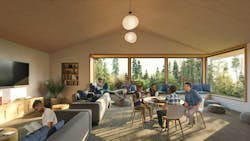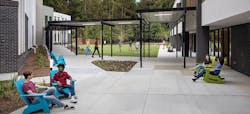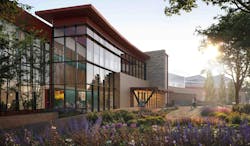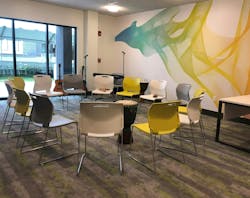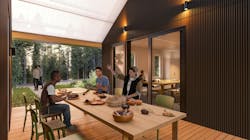Designing Behavioral Health Spaces: Comfort, Calm, and Outdoor Areas for Enhanced Patient Care
Driven by pandemic-induced anxiety and loneliness, and the destigmatization of mental health care, growth in behavioral health services is at an all-time high.
According to Mental Health America’s 2023 report, an astounding 21 percent of adults are experiencing mental illness—the equivalent of more than 20 million Americans. Of that population, 55 percent have not sought treatment.
Fortunately, this percentage is decreasing now that seeking therapy and clinical treatment is no longer viewed as a sign of personal weakness or character defect. However, the increase in market demand is significant.
In addition, substance abuse, the opioid crisis, an aging population leading to a higher percentage of dementia cases, and a societal increase in mass shootings and natural disasters are boosting stress and anxiety.
As healthcare providers scramble to upgrade and build new clinics and facilities to serve the fast-growing demographic, architects and interior designers are rising to the challenge to cater to the unique needs of this population.
Behavioral Health Design Trends
Because a well-designed built environment can play a significant role in treatment and recovery, while a poorly-crafted facility can heighten anxieties and conflict, key design principles must be carefully considered.
In line with what providers are seeking for these spaces, Jon Sell, principal and senior behavioral health planner with Stantec in Philadelphia, says his team is specifying products and finishes that reduce the risk of self-harm, as well as comfortable furnishings, access to natural light, and calming lighting and colors.
“For patients to recover, they need to feel safe and supported, and they need to have a voice and choice in their care,” Sell explained. “When a patient arrives at a facility, they need to give up everything—their personal effects and often their clothing—which can be a very traumatic and demoralizing feeling.”
Maggie Mitchell, IIDA, associate and senior interior designer, Dyer Brown & Associates, Atlanta, added, “Access to lighting controls, for example, is a small design gesture that engenders trust and feelings of security and empowerment, and the same goes for doors and partitions that the patient can open or close for privacy as needed.”
Toward this end, Elisandra Garcia, director of engagement and a project designer with El Dorado in Portland, recommends lightweight movable furnishings and controls for climate, lighting, and privacy.
To promote relaxed and calming spaces, Stantec employs design strategies including color-changing light, a peaceful landscape image, personalized sound, custom airflow, aromatherapy, tactile panels, and comfortable furniture.
Customizing their designs for this population, Dyer Brown likes to cross-pollinate from the hospitality and workplace sectors, and integrate dynamic types of therapy like horticulture, meditation, music, art, and physical fitness.
And as is the case with all institutional and commercial facilities, daylighting and exposure to the outdoors are key.
“Evidence-based design research suggests that access to outdoor spaces as well as views of outdoors from inside are essential to progress and successful outcomes for patients,” Mitchell said. “The design supports our intuition that natural daylight and views of nature contribute positively to mental health treatment.”
From small porches to large outdoor courtyards, Sell asserts that the biophilic design principles of natural light and fresh air are absolutely necessary in behavioral health facilities.
For instance, in the case of a large state forensic facility, Stantec designed outdoor spaces for varying levels of engagement, including a quiet contemplative space and large outdoor recreation with basketball, exercise equipment, and horticultural therapy.
For these types of projects, Sell also emphasizes the importance of good acoustics and flexible designs.
Because materials specified in behavioral health facilities must consider maintenance, cleaning protocols, and impact resistance, hard surfaces are often selected. Consequently, acoustic elements and controls must be incorporated to mitigate this. As for flexibility, these centers need the ability to easily reconfigure furniture and partitions to accommodate distinct types of therapies and settings throughout the day.
Evolving Trends: Trauma-informed and Community-based Healthcare
Looking toward the future, Garcia anticipates that trauma-informed design (TID) will become a more common part of the design vernacular in the behavioral healthcare sector.
“While still emergent, there is increasing interest in TID approaches and in the development of standards for architects and designers to draw on,” she explained. “Direct engagement with a specific traumatized population and their caregivers will always inform an optimal design approach for that unique treatment environment.”
In an effort to direct mental health patients away from hospital emergency rooms, the folks at Dyer Brown believe there will be an increase in community-based treatment settings. Mitchell also foresees these new construction projects and retrofits will incorporate safety, security, choice and control, access to nature and daylight, privacy, and positive social interaction.
With regard to lending more freedom and choice to patients, Sell predicts that technology will play an evolving role. For example, a greater application of wearables and monitoring devices would allow patients to be less restricted while remaining safe.
Offering another prediction, he projects, “Augmented reality will be used to create more immersive environments that will drive treatments such as exposure therapy.”
For the Teens
An interesting project is currently underway for a multi-phased expansion and renovation of an 80-acre campus in Oregon City, Ore., for the nonprofit Parrott Creek Child + Family Services.
The project is unique in that the design is not following a pre-determined standard or set of design principles, but rather the input is coming solely from the practitioners and end users.
This direct engagement seeks to arrive at the ideal prescription for spaces in which traumatized young people can remain regulated and feel safe.
El Dorado’s design for this residential treatment program for children and families affected by addiction embraces natural daylight and views of the outside, and places an emphasis on privacy and control.
When complete, Parrott Creek will feature a courtyard setting nestled among the residential structures as well as outbuildings and landscaped areas for therapy.
About the Author
Barbara Horwitz-Bennett
Contributing Editor
Barbara Horwitz-Bennett has been covering the AEC industry for the past 25 years. She writes for a number of industry magazines and works with AEC firms and product manufacturers on content writing projects.
